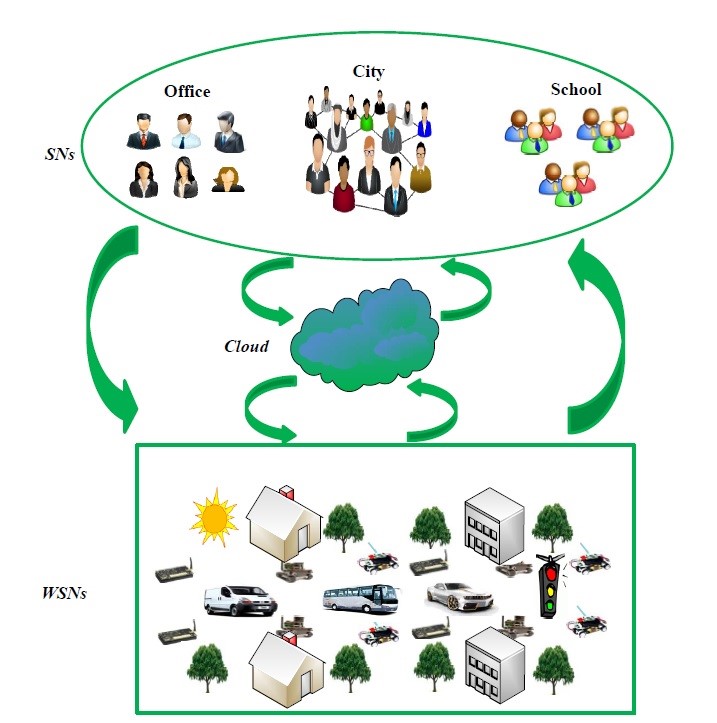Location Based Power Reduction Cloud Integrated Social Sensor Network
Main Article Content
Abstract
It is great to hear about the advancements in wireless sensor networks and their applications, as well as the integration of cloud computing to enhance data analysis and storage capabilities. Indeed, these technologies have opened up numerous possibilities across various fields, including infrastructure tracking, environmental monitoring, healthcare, and more. The concept of a social sensor cloud, as you mentioned, brings an interesting dimension to this technology landscape by focusing on knowledge-sharing and connecting like-minded individuals or organizations. This could potentially lead to more collaborative and efficient solutions across a wide range of domains. Energy efficiency is a critical consideration in the design and operation of wireless sensor networks and the cloud infrastructure that supports them. The limited battery life of sensors necessitates careful management of energy consumption to ensure optimal functionality and longevity. Sleep scheduling methods are a common technique used to manage energy consumption in these networks. By coordinating when sensors are active and when they are in a low-power sleep mode, energy consumption can be significantly reduced without compromising the network's overall effectiveness. In the context of the Social Sensor Cloud, managing energy efficiency becomes even more crucial due to the shorter battery life of the sensors involved. This is particularly relevant given the growing concerns about environmental sustainability and the need to reduce energy consumption across technological systems. It's clear that your research paper addresses these challenges head-on, by exploring energy-efficient techniques for the Social Sensor Cloud. Sleep scheduling is just one of the many strategies that researchers and engineers are working on to strike a balance between functionality and energy consumption. Other methods might include optimizing data transfer protocols, developing energy-harvesting mechanisms, and enhancing sensor hardware efficiency. As technology continues to evolve, the integration of wireless sensor networks, cloud computing, and social networks will likely pave the way for innovative solutions and transformative applications. Addressing energy efficiency concerns will undoubtedly play a crucial role in ensuring the long-term viability and positive impact of these technologies.
Article Details
References
Umer, T., Rehmani M., Ahmed E. and Mihaylova L, “Information and resource management systems for Internet of Things: Energy management, communication protocols and future applications”, Future Generation Computer Systems, ELSEVIER, 2019.
Dwivedi R., Saran M. and Kumar, R.,” A Survey on Security over Sensor-Cloud”, IEEE, 2019.
Malik, B., Ali, M., Yousaf, S. and Mehmood M,” Efficient Energy Utilization in Cloud Fog Environment”, IJACsa, 2019.
Saravana Kumar, J., “Green Smart World (Internet of things)”, International Journal of Engineering Science Invention (IJESI), 2019.
Mohamad Noor, M. and Hassan, W., “Current research on Internet of Things (IoT) security: A survey”, ELSEVIER 2019.
Singh, R., Singh, S., Kumar, R, “Integration of Wireless Sensor Networks with Cloud: A Review”, IEEE 2019.
Abed, S., Shayeji, M., and Ebrahim, F., “Secure and Energy-Efficient Platform for theIntegration of Wireless Sensor Networks andMobile Cloud Computing”, ELSEVIER, 2019.
Arroyo, P., Herrero, J., Suárez, J., and Lozano, J.,” Wireless Sensor Network Combined with Cloud Computing for Air Quality Monitoring”,Sensors,2019.
Hang, L., Jin, W., Yoon, H., Hong, Y., and Kim, D., ” Design and Implementation of a Sensor-CloudPlatform for Physical Sensor Management onCoT Environments”, Electronics, 2019.
Abed1, S., Al-Shayeji1, M., and Ebrahim, F., “Secure and Energy-Efficient Platform for theIntegration of Wireless Sensor Networks andMobile Cloud Computing”, ELSEVIER, 2019.
Santhana, V., and Shanmugam, D., “Integrating Wireless Sensor Networka with Cloud Computing and Emerging IT Platforms Using Middleware Services” ,IRJET, 2018.
THANH DINH, N., and KIM, Y., ” An Energy Efficient Integration Modelfor Sensor Cloud Systems”, IEEE, 2018.
Das, K., Das, S., Darji, R., and Mishra, A., “Survey of Energy-Efficient Techniques for the Cloud-Integrated Sensor Network”, Journal of Sensors, 2018.
Zhu, C., Leung, V., Rodrigues, J., Wang, L., and Zhou, H., “Social Sensor Cloud: Framework, Greenness, Issues, and Outlook”, IEEE 2018.
Hasan, W., Agbinya, j., Ran, Y., and Gui Yun Tian, G., “A Survey of Energy Efficient IoT Network in Cloud Environment”, International Conference on Cyber Security & Communication Systems, ICCSCS 2018.
Madria, S., “Sensor Cloud: Sensing-as-a-Service Paradigm”, IEEE International Conference on Mobile Data Management, 2018.
Srivastava, R., and Hasan, M., “Comparative Study on Integration of wireless sensor network with cloud computing”, International Journal of Advanced Research in Computer Science, IJARCS, 2018.
Park, D., “Future computing With IoT and cloud computing”, the Journal of Supercomputing, 2018.
Tsvetanov, F., and Pandurski, M., “Some Aspects for the Integration of Sensor Networks in Cloud Structures”, European Union, 2018.
Dwivedi, R., and Kumar, R., “Sensor Cloud: Integrating Wireless Sensor Networks with Cloud Computing”, IEEE , 2018.
AbdElnapi, N., Omran, N., Ali, A., and Omara, F., “A Survey of Internet of Things Technologies and Projects for Healthcare services”,IEEE 2018.
Jindal, F., Jamar, R., and Churi, P., “Future and Challenges of IoT”,International Journal of Computer Science & Information Technology(IJCSIT), 2018.
Cha, H., Yang, H., and n Song, Y., ” A Study on the Design of Fog Computing Architecture Using Sensor Networks”, Sensors, 2018.

